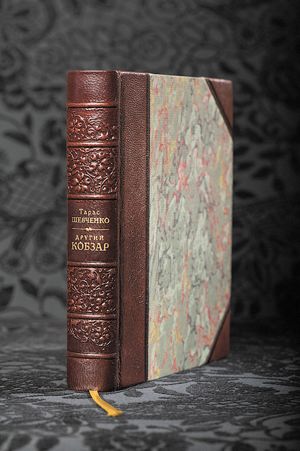Taras Shevchenko, 21st century
The poet’s book was destined to come out only in 2008, thanks to researcher Serhii Halchenko
“I’m going to publish my second Kobzar…” Shevchenko wrote shortly before his arrest on the Dnipro crossing, on April 5, 1847. Incredibly, his creative project became a reality only in 2008, thanks to long years of work by Serhii Halchenko, a dedicated researcher of Shevchenko’s heritage.
Shevchenko left no complete list of works that were to be included in the second Kobzar, but painstaking research of the manuscripts stored at the National Academy’s Shevchenko Institute of Literature prompted Halchenko to include in the collection manuscripts that were impounded during the arrest. At the time Shevchenko, a member of the Brotherhood of Saints Cyril and Methodius, was found to have a number of papers, including two notebooks, a large one entitled “Three Summers” and a double one that included the poem Osyka, a foreword, and the ballads Mermaid and Lileia.
In the collection, compiled by Halchenko, the second notebook contains text in modern format, with footnotes and commentaries, and the manuscripts using the facsimile technique. This format allows the reader to perceive the poet’s creative insight, the grandeur of the manuscripts prepared for publication.
Without exaggeration, the facsimile part’s true masterpiece is Wirszy T. Szewczenka, 1844, a scholarly edition compiled by Halchenko and published in Dniprodzerzhynsk the same year as the Second Kobzar. This manuscript is among the unique literary gems stored in the Institute of Literature’s archives. It includes the Kobzar published in 1840, the poems Haidamaks (1841) and Hamalia (1843) in Polish Latin transliteration and illustrated by Mykhailo Bashylov and Yakiv de Balmen.
The story of this collection and its storage is rich in mysteries. Modern Shevchenko researchers believe the texts of the manuscripts were copied by de Balmen, but that he used texts other than those included in the 1840 Kobzar — texts that may have avoided censorship and belonged to the poet. These texts may have been prepared for publication in Latin transliteration, so they could be read by Western Slavs, and also to avoid tsarist censorship and promulgate Shevchenko’s original manuscripts in Right-Bank Ukraine, considering that its population mostly used the Latin alphabet. Shevchenko’s corrections are proof of his painstaking work on the future book.
A collection of manuscripts with Bashylov and de Balmen’s illustrations was confiscated during the arrest of Associate Professor Mykola Kostomarov. When interrogated, he testified that he needed it to work on a dictionary of Little Russian vernaculars. This rarity was stored in the secret archives of the police department in St. Petersburg until it was destroyed in 1917. The handwritten text’s further path was winding and thorny until it ended up in the archives of the Shevchenko Institute of Literature at the Academy of Sciences of the Ukrainian SSR in 1936.
Both these collections are available in print in three formats: economy, souvenir, and exclusive. The latter boasts expensive handmade compound shagreen covers with lettering in flat and raised relief. The rounded spine is decorated with bands, relief stamping and gold lettering. The inner book contains text in offset with four colors, using several kinds of designer paper.
The publication of these masterpieces of book printing marks a significant event for two reasons, in my opinion. Firstly, Shevchenko’s creative project has been carried out more than 160 years later, by the National Academy of Sciences of Ukraine and the Institute of Literature — namely by Halchenko. Researchers specializing in Shevchenko and readers now have another opportunity to look at the brilliant poet’s heritage from a different angle, using original sources.
Secondly, for the first time in modern Ukraine, a scholarly edition of a Ukrainian classic appears in print at the expense of national charitable donations. This revives the true Ukrainian philanthropic spirit and makes this research accessible to broad public circles, with the end result being commercially attractive to the publishers.
The fact that Shevchenko’s Second Kobzar has been reprinted this year, with a circulation of several thousand copies, is proof that quality books by Ukrainian classics are in demand, as are original studies and novel interpretations of seemingly long known texts. This is a trend that has to be developed.
Owing to Halchenko’s two projects, a Taras Shevchenko of the 21st century emerges, without censorship and biased attitude, in an exclusively designed book with the author’s texts. This book will embellish any library, it will constantly attract attention and prompt the reader to re-discover the immortal lines written by one of the most outstanding founding fathers of Ukrainian literature.






